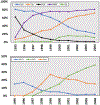Immunosuppression trends in solid organ transplantation: The future of individualization, monitoring, and management
- PMID: 33131123
- PMCID: PMC8778961
- DOI: 10.1002/phar.2481
Immunosuppression trends in solid organ transplantation: The future of individualization, monitoring, and management
Abstract
Immunosuppression regimens used in solid organ transplant have evolved significantly over the past 70 years in the United States. Early immunosuppression and targets for allograft success were measured by incidence and severity of allograft rejection and 1-year patient survival. The limited number of agents, infancy of human leukocyte antigen (HLA) matching techniques and lack of understanding of immunoreactivity limited the early development of effective regimens. The 1980s and 1990s saw incredible advancements in these areas, with acute rejection rates halving in a short span of time. However, the constant struggle to achieve the optimal balance between under- and overimmunosuppression is weaved throughout the history of transplant immunosuppression. The aim of this paper is to discuss the different eras of immunosuppression and highlight the important milestones that were achieved while also discussing this in the context of rational agent selection and regimen design. This discussion sets the stage for how we can achieve optimal long-term outcomes during the next era of immunosuppression, which will move from universal protocols to patient-specific optimization.
Keywords: immunosuppression; solid.
© 2020 Pharmacotherapy Publications, Inc.
Conflict of interest statement
CONFLICT OF INTEREST
L.J.B. is a member of the Speakers Bureau for Veloxis Pharmaceuticals. All other authors declare no conflicts of interest.
Figures




References
Publication types
MeSH terms
Substances
Grants and funding
LinkOut - more resources
Full Text Sources
Medical
Research Materials
Miscellaneous

